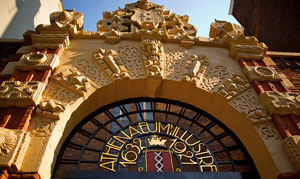De innovatieve universiteit

Having looked for some 30 odd years from a university insideout, it is now time to look from the outside in: focusing on theuniversity’s potential contribution to innovation. Whenever onedeals with innovation, the university pops up as a player (Drewe,2006, 2009a,b). Sometimes they are even advocated as panacea.Universities are not a ‘quantité négligeable’. There are around4000 institutions of higher education in Europe and 435000researchers, employing around one and a half million people.
Especially US-Americans love practical manuals or guides of the’How-to type’, with a preference for ‘Do´s’ or recommendations.Dealing with the innovative university, however, we rather preferto focus on ‘Don’ts’ or warnings. Learning from bad practice is asource for don’ts. Institutions targeting universities such as theEU or national governments – in quest for good or even bestpractice – find it difficult to accept that they have funded badpractice. One can even learn more from bad than from goodexperience. Bad practice tells us that a general recipe or curedoes not work. The underlying hypothesis has been falsified.Remember the time-honored principle of falsifiability (see alsoTaleb, 2008).
Something Else
According to the European Commission, universities have three coremissions: teaching, research and contributing to innovation. Thelatter as a ‘stand-alone function’ is a newcomers as,traditionally, the main tasks have been teaching and research plus’something else’. Starting from research and teaching, the questionis what universities can contribute to innovation and what pitfallsare to be avoided.
But first a word about ‘something else’, vaguely described asthe university being a transmitter of culture, having wider socialand cultural responsibilities or even being a ‘finishing school’.This aspect is less tangible than teaching and research, difficultto measure and therefore the first to be discarded when publicresources turn stringent. Whether this is wise, will occupy uslater.
The university agenda today is written by the EU. The magic wordhere is ‘knowledge economy, of which higher education and researchshould be the leading protagonists’ (Buysse, 2009: 27). The readeris referred to Commission of the European Communities (2006)[1].
The don’ts will be expressed in a series of ‘one-liners’addressed to those working at universities, those who decide onuniversity matters, and scholars studying the role of theuniversity.
Let us start with university research. Here is a firstwarning.
1. Don’t think that universities are eithernecessary or sufficient when it comes to promoteinnovation
(This holds both for research and teaching)
Universities are major players in research: employing about athird of all researchers and providing 80% of basic research inEurope. But this magnitude does not automatically make it a majorplayer in contributing to innovation. Universities are only one ofmany places where research is done, in addition to public,semi-public, private research institutes, and in-house research ofbusiness firms (there are also think tanks and consultancies). Takefor example Germany with its rich tradition of public researchinstitutions such as Max Planck, Leibniz, Fraunhofer and theVolkswagen Foundation. They can be more important sources ofinnovation-prone research than universities. But instead of beingcompetitors, universities can opt for partnerships (public-public,public-private) with the real protagonists of innovation-proneresearch, not to forget business firms.
2. Don’t underestimate in-house research of businessfirms
Musso, Ponthou & Seuillet (2005, 2007) have reconstructedthe history of more than 150 successful innovations, both newproducts and new services (in companies like Electrolux, Nokia,Ideo, Danone, Décathon, Tribord, France Télécom). The authors shedlight on a new innovation process which, unlike the traditionalone, is user-oriented (see also Vredenburg, Isensee &Righi, 2002). The ‘inventors’ are confronted with the users in amulti-actor environment including state firms, advertising andmarketing studies, and various ‘littérateurs’ (journalists,novelists, moviemakers and the like). The new innovation process iscyclical, not linear. It comprises five phases and a number offeedback loops. The five phases are:
– observing, studying, watching and analyzing clients, marketsand trends
– generating supply concepts
– illustrating, scenario building, modeling, prototyping,simulating
– testing, confronting with reality
– priorities, selecting, choosing for implementation
The whole process is fueled by ‘imagination’ or ‘which is notintangible but the field of work of scientific and technicallaboratories, designers and artists. ‘L’imaginaire’ can also bemanaged by companies.
The lesson from this for universities is:
3. Don’t pursue the old, supply-oriented,technology-push approach to innovation any longer
The old process, cherished in particular by universities oftechnology, is basically a linear, non-user oriented process: fromfundamental research (hopefully) to the commercial exploitation ofresults, via inventions, prototypes and marketing.
How far should universities go in their quest for innovation?Should they create spin-offs and other spin-offs?
4. Don’t write off start-ups
Entrepreneurship is the link between science and innovation(Ropke & Kozlova, 2004). The number of start-ups originatingfrom universities (preferably producing basic innovations leadingto new industries) depends on university regulations concerningentrepreneurial initiatives and the allocation of profits frominnovations. A second factor is the university’s reputation orrather the reputation of its researchers. How can they betrained?
5. Don’t give up on Von Humboldtyet
Von Humboldt, in the early 19th century, pleaded fora university that integrates teaching and research. What better wayof recruiting new talent and potential innovators: ‘Humboldt +Schumpeter = innovative university’ (Ropke & Kozlova).
In positioning themselves, universities today are increasinglyexposed to rankings. An extreme case is the world ranking by theuniversity of Jiao Tong (see illustration Le Monde) [2].
6. Don’t take rankings too seriously; don’t wasteyour energy on either embracing favorable rankings or on fightingunfavorable ones
Rankings are a neoliberal hype (Pehrke, 2007). The Bible tellsus that ‘Many are called, but few are chosen’. Should one take thisas an argument in favor of social Darwinism or ‘the survival of thefittest’? One has to accept that ‘not every university can play inthe Champions League’ so to speak. However this does not plead forrankings (and benchmarking) . But there are different degrees offitness.
With around 4000 higher education institutions in Europe itwould be surprising not to find a great diversity. One cannotpretend that all universities are equal. Maybe one should speak of’multiversities’ (Clark Kerr). The top-down Bologna process,however, rather seems to imply that ‘one size fits all’. Eachuniversity has to define its own doable standards of good teachingand good research.
Apart from using favorable rankings for marketing purposes orattacking the method that has produced an unfavorable ranking,university can even do much worse, that is: use rankings forbenchmarking and – in the case of not playing in the ChampionsLeague – trying to bridge the gap.
7. Don’t use rankings for benchmarkingpurposes
An extreme case is the so-called MIT envy. A Dutch universityonce has chosen MIT as its idol. But can you really compare apublic university in the Netherlands, struggling with its budget,with a rich private university in the US? (although the richness ofprivate universities has suffered from the financial crisis unlessthey flog their real estate). Generally speaking, using rankingsfor benchmarking seems to be a sure way for European universitiesto waste money.
According to Bain & Company, over the past ten yearsbenchmarking has become the most popular management technique atthe expense of strategic planning which seems a better tool formanaging universities as non-profit companies.
That universities are neither necessary nor sufficient when itcomes to promote innovation, also holds for teaching, in particularfor its role as a professional school, and with regard to technicaland vocational teaching.
8. Don’t live ‘with the windows shut’ as far asprofessional teaching is concerned
There are professional schools at different levels from high tolow. There are also Open Universities with Open Educational orResources dedicated to lifelong learning (Janssen, Mulder &Schuwer, 2007). Didn’t José Manuel Barroso claim that ‘lifelonglearning is a sine qua non if the Lisbon objectives are to beachieved’. Once again, all kinds of partnerships can be imaginedand should be experimented with.
What exactly is the link with innovation? This link consists inproviding the right skills. There are different ways of meeting thedemands for skills that are critical for innovative clusterdevelopment (dti, 2007). Once again, user-orientedness is calledfor, to provide e.g. advice and guidance, training for newentrants, training for re-entrants, a broadening of the skillsbase, management development and the like.
9. Don’t underestimate the potential of ICT andvirtual universities
The model is already provided by Open Universities with theirOpen Educational or Learning Resources. A virtual university ismore than just than e-mails, powerpoint- presentations and othervisualization and communication tools: ‘… it is difficult to feelloyal to your alma mater when your most interesting discussions arewith distant colleagues in electronic space’ (The Economist, 1997:21). In fact, various research and teaching networks, using ICT,are already embryonic virtual universities. If one wants to graspthe full potential of ICT, this is also a matter of content. Takefor example urban planning (Drewe, 2009c).
10. Don’t refuse to cooperate with the actors ofinnovative milieux
Innovative milieux have been dealt with in greater detail byDrewe (2009a,b). An innovative milieu, in brief, is characterizedby :
– a group of actors
– material, immaterial and institutional elements
– cooperation
– learning or ‘apprenticeship’.
Universities are usually one of the actors meeting with theoutside world of business firms, other research and educationalinstitutions, and with local public authorities. Universities areinstitutions that provide material elements such as real estate aswell, less visible, a certain know how. Together with the ‘outdoor’actors, universities cooperate, learn and engage intransterritorial networks.
Meest Gelezen
Vrouwen houden universiteit draaiende, maar krijgen daarvoor geen waardering
Hbo-docent wil wel rolmodel zijn, maar niet eigen moreel kompas opdringen
Wederom intimidatie van journalisten door universiteit, nu in Delft
‘Waarom het nu niet lukt om medezeggenschap in hbo te versterken’
‘Sluijsmans et al. slaan de plank volledig mis’



